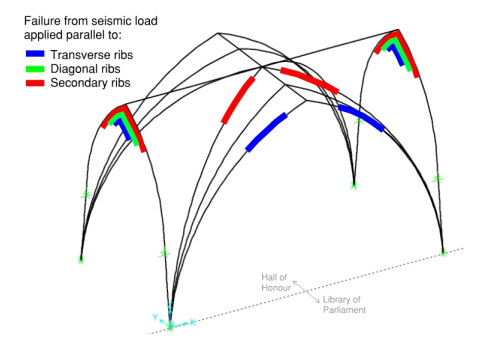Isis Bennet, Relja Lukic, Carl Mohammadi
i Structural Engineer, WSP Canada, Ottawa, Canada, Isis.Bennet@wsp.com
ii Structural Engineer, WSP Canada, Ottawa, Canada, Relja.Lukic@wsp.com
iii Senior Structural Engineer, WSP Canada, Ottawa, Canada, Carl.Mohammadi@wsp.com
ABSTRACT
Preserving our built heritage necessitates the analysis of historic structures under new loading conditions to bring structural performance up to modern codes and to accommodate changes to the building use or configuration. This case study looks at the performance of a masonry gothic rib vault ceiling under seismic loading and alteration to the existing load path. The rib vault within Canada’s central parliament building, Centre Block, was designed with traditional analysis methods, and has supported its self-weight for over a century. The rehabilitation of Centre Block involves the introduction of a movement joint that will seismically separate the attached Library of Parliament. This joint would disrupt the existing gravity load path of the historic rib vault ceiling requiring restraint of the thrust crossing the joint as well as a reassessment of the vault’s stability. Traditional analysis methods are adequate for assessing capacity and stability under gravity and seismic loads. However, these methods become insufficient when the gravity load path is altered, and finite element analysis (FEA) can provide useful insight into structural behaviour. This case study presents a methodology for validating an FEA model through traditional thrust line and kinematic methods. Modern standards are discussed and are applied to the results. This approach allows for the evaluation of the vaulted ceiling stability and informs the design of future interventions to ensure its preservation under new support conditions and seismic demands.
KEYWORDS: Thrust line analysis, unreinforced masonry, finite element analysis, masonry arches, vaulted stone ceilings, seismic.
138-Bennet.pdf



